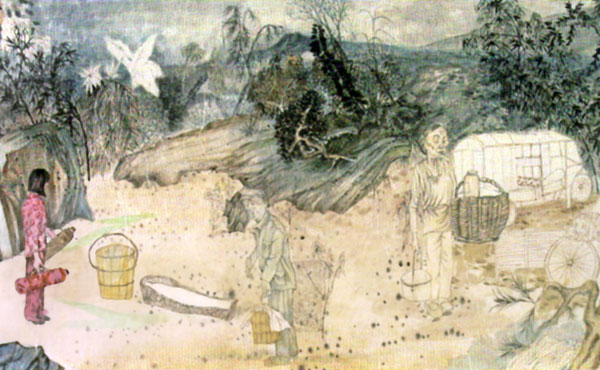For ‘Art on Paper’ magazine

Yun-Fei Ji is on a mission. In the past year, this Brooklyn-based painter has presented two major solo painting shows in New York that fiercely condemn the newly built Three Gorges Dam in China’s Hubei province. Last spring, Ji’s lively depictions of village life expressed equal parts affection for country life and disgust at the corruption and ignorance that threatened to make that life extinct. Now that the cities and villages along the dammed Yangzi River have been dismantled, millions of people have been relocated and the waters have risen, the mood of the new paintings is mournful. Scavengers, stragglers, and eerie skeletal figures go about their business in literal ghost towns.
Although the series is collectively titled ‘The Empty City,’ the best paintings are ironically those with the most people. ‘Bon Voyage’ (2003), the busiest, juxtaposes frantic villagers leaving their old life in the midst of swirling waters with partying tourists onboard a cruise ship on the newly widened river. In ‘East Wind’ (2003), an equally riotous scene, Red Guards make their way down a rocky, refuse strewn valley wall amongst shirtless village men who look too weak and helpless to object.
Because Ji’s sometimes bizarre animal and human characters are the most intriguing parts of his paintings, some of the less populated scenes run the risk of simply repeating his iconographic repertoire of ghostly figures moving amongst piles of building supplies and equipment. This is especially true of ‘Autumn’ (2003), in which the fall foliage is beautiful, but none of Ji’s skilled caricatures appear.
Nevertheless, by selecting the rock formations and flora of the countryside as the setting for his paintings, instead of the cities where the upheaval is more pronounced, Ji wisely chooses an intimate means to portray the destruction of a lifestyle in place for centuries. He zeros in on the frail bodies and wizened faces of a population familiar with hardship but who will now endure much worse. Haunted by the ghosts of the country’s past and unable to foresee the future in this area, Ji and others look on, helpless to stop the heartbreaking march of ‘progress.’